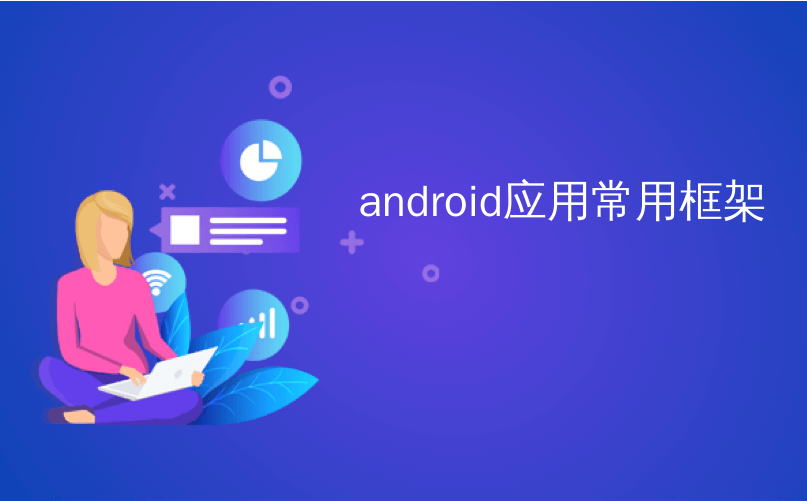
android应用常用框架
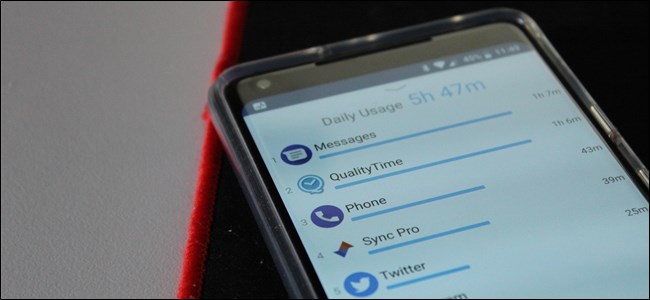
Have you ever wondered which apps consume most of your time? Sure, you can assume what you use the most, but seeing exactly what you use (and how often) can be pretty telling. The best part is that finding this info is as simple as installing an app from the Play Store.
您是否曾经想过哪些应用会占用您的大部分时间? 当然,您可以假设您使用最多的东西,但是准确地知道使用的东西(以及使用频率)可以说得很清楚。 最好的部分是,找到此信息就像从Play商店安装应用程序一样简单。
To track app usage, we’re going to use an app called Quality Time. It’s a simple app that’s easy to use and provides a lot of good information in an intuitive interface—and it’s also free. You really can’t ask for more than that.
为了跟踪应用的使用情况,我们将使用一个称为Quality Time的应用。 这是一个简单的应用程序,易于使用,并在直观的界面中提供了很多有用的信息-并且它是免费的。 您真的不能要求更多。
设置和使用质量时间 (Setting Up and Using Quality Time)
To start, install Quality Time and set up and account. You can log in with Facebook if you want, otherwise just set a new account up from scratch.
首先, 请安装质量时间并进行设置和帐户设置。 您可以根据需要使用Facebook登录,否则可以从头开始设置一个新帐户。
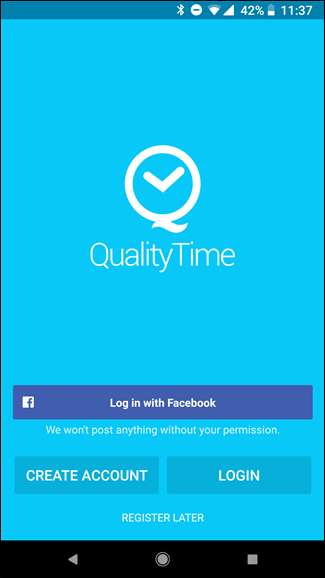

Once you’re logged in, you’ll need to grant Quality Time app usage access. Tap the “Permit” button, then “Quality Time,” then toggle usage access to On. This is what allows Quality Time to track your usage patterns—without this setting, the app can’t do what it’s designed to do.
登录后,您需要授予Quality Time应用使用权限。 点击“许可”按钮,然后点击“质量时间”,然后将使用权限切换为“打开”。 这就是让Quality Time跟踪您的使用模式的原因-如果没有此设置,该应用程序将无法执行其设计的工作。
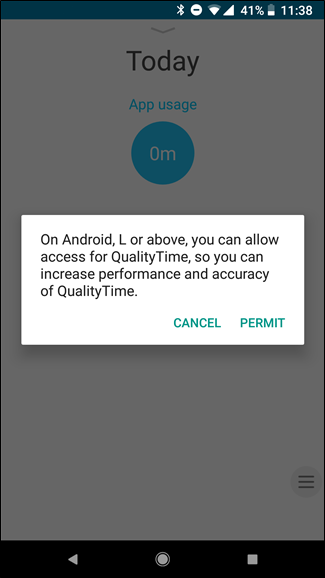
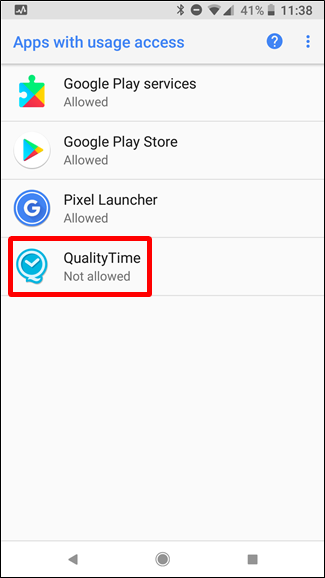
From there, Quality Time will start tracking your usage. It can’t see anything from before the app was installed (or before usage access is granted if you installed it and didn’t set it up), so you’ll start with a clean slate.
从那里,Quality Time将开始跟踪您的使用情况。 从安装该应用程序之前(或者如果您安装了该应用程序但未设置该应用程序,在授予使用权限之前),它就看不到任何内容,因此,您将从一个干净的表盘开始。
As you use your phone from now on, however, Quality Time will track your behavior. This includes how much time you spend in all your apps, how many times you open those apps, and how many times you unlocked the screen. It tracks this information on a daily and weekly basis, so on a longer timeline it gets very useful.
但是,从现在开始使用手机时,Quality Time将跟踪您的行为。 这包括您花在所有应用程序上的时间,打开这些应用程序的次数以及解锁屏幕的次数。 它每天和每周跟踪此信息,因此在较长的时间轴上它很有用。
The layout is a little different than what you may be used to in most Android apps, but once you understand how it works, it makes Quality Time very efficient at what it does. The app opens on the Today screen, which shows all of your activity from the current day in a nice timeline format.
布局与大多数Android应用中的布局略有不同,但是一旦您了解了它的工作原理,它就会使Quality Time的工作效率非常高。 该应用程序将在“今日”屏幕上打开,该屏幕以漂亮的时间轴格式显示当天的所有活动。
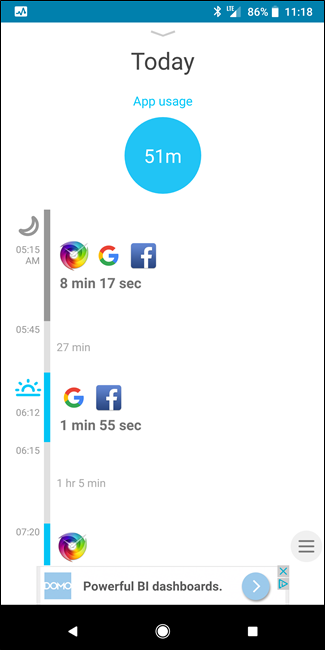
The breakdown here is pretty simple: tracking starts each day the first time you open your phone—so generally when your alarm goes off. The app keeps usage sorted into clusters since most of us don’t turn the display off before launching each new app, but it also tracks idle time. To get a minute-by-minute breakdown, tap on one of these clusters.
此处的分类很简单:第一次打开手机时,跟踪每天都会开始,因此通常在闹钟响起时开始。 该应用程序将使用情况归类,因为我们大多数人在启动每个新应用程序之前不会关闭显示屏,但它还会跟踪空闲时间。 要获取按分钟分类的详细信息,请点击这些群集之一。
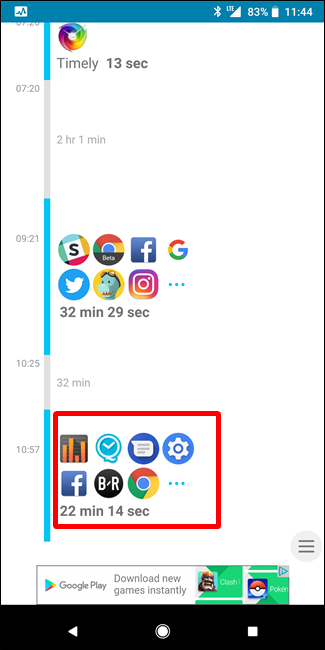

To get a bigger overall view of your day, swipe down from the Today screen. This will take you from the Today view to the Daily Usage view, which gives a quick look at which apps you’ve launched the most and how much time you’ve spent in each one. Additionally, you can swipe left to cycle through various bits of information about your app activity, like how many times you opened each app and unlocked your phone. You can also swipe through days using the section at the bottom.
要全面了解您的一天,请从“今日”屏幕向下滑动。 这将使您从“今天”视图转到“每日使用情况”视图,该视图可让您快速查看您启动次数最多的应用程序以及在每个应用程序中花费了多少时间。 此外,您可以向左滑动以循环显示有关应用程序活动的各种信息,例如打开每个应用程序和解锁手机的次数。 您也可以使用底部的部分在几天内滑动。
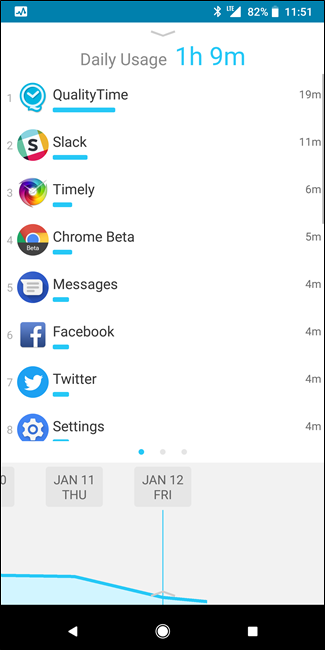
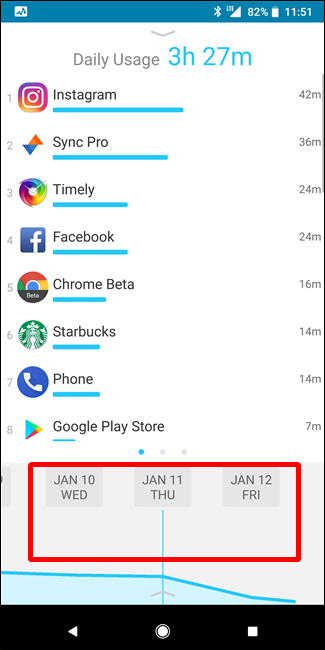
If you swipe down on the screen from the Daily Usage, this will bring up the Weekly Usage view. This shows your collective usage for the week, where you can again swipe through frequencies and unlocks on the top half, as well as various weeks at the bottom.
如果从“每日使用情况”在屏幕上向下滑动,将弹出“每周使用情况”视图。 这显示了您本周的集体使用情况,您可以在其中再次滑动频率并在上半部分解锁,并在底部的各个星期解锁。

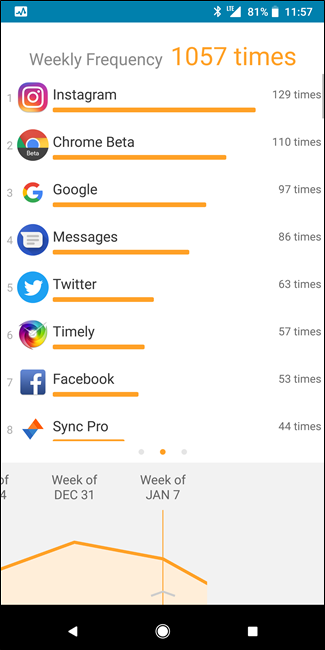
Tapping on any single app in either the Daily or Weekly view will show you the respective details just for that app. From this view, you can swipe over one screen to the left to also see how many times you opened the app. I feel like this is information that should really just be shown on the same screen, but whatever. Again, you can swipe through days at the bottom.
在“每日”或“每周”视图中轻按任何单个应用程序,将仅显示该应用程序的详细信息。 在此视图中,您可以向左滑动一个屏幕,以查看打开该应用程序的次数。 我觉得这是应该真正在同一屏幕上显示的信息,但无论如何。 同样,您可以在底部浏览几天。
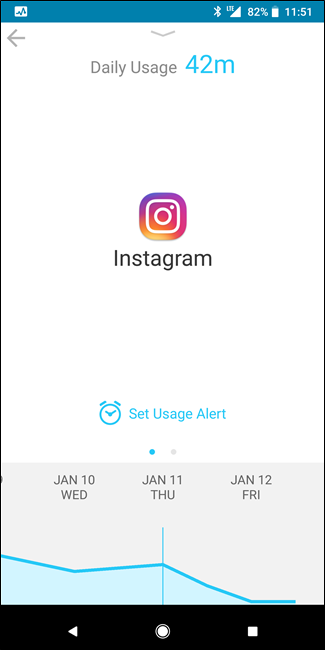
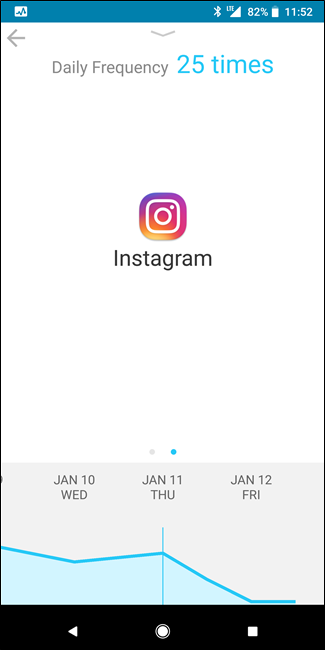
Also on the Daily Usage page, you can tap on the day itself to display a usage graph. This is a pretty cool thing to see when you’re most actively using your phone. Note that the app usage chart doesn’t change here, just the line graph at the bottom.
同样在“每日使用情况”页面上,您可以点击日期本身以显示使用情况图表。 当您最积极地使用手机时,这是一件很酷的事情。 请注意,此处的应用使用情况表不会改变,只是底部的折线图。
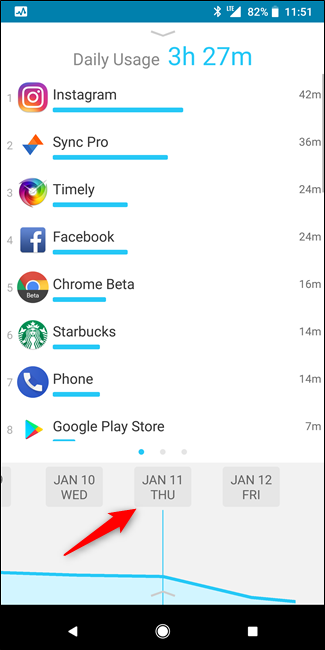

优质时间的额外功能 (Quality Time’s Extra Features)
That’s all there is to Quality Time’s primary interface—it’s very straightforward. It does, however, have a few extra features under its sleeve, like a nifty “take a break” feature that “forces” you to put your phone down for a little while.
这就是Quality Time主要界面的全部-非常简单。 但是,它确实有一些额外的功能,例如漂亮的“休息”功能,“迫使”您将手机放下一会儿。
To access this feature, scroll all the way down to the bottom “page”—the Today view—and tap the three lines at the bottom to open the menu. From there, tap on “Take a break,” which will prompt you to set up a Quality Time Profile.
要访问此功能,请一直向下滚动到底部的“页面”(“今日”视图),然后点击底部的三行以打开菜单。 在此处,点击“休息一下”,这将提示您设置质量时间配置文件。

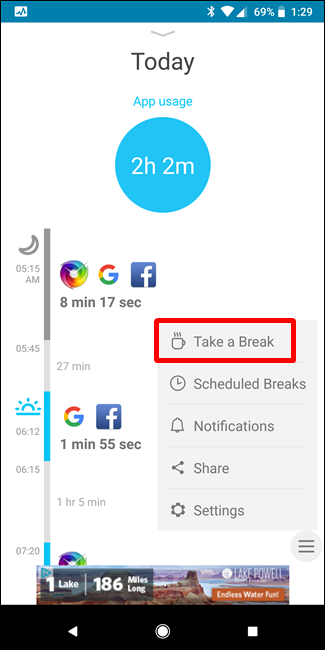
You’ll need to give your profile a name to start, then choose how much of a break you want to take by choosing to block notifications and/or calls. You can also allow certain apps to bypass the break.
您需要给个人资料起一个名字,然后通过选择阻止通知和/或呼叫来选择要休息的时间。 您还可以允许某些应用绕过中断。
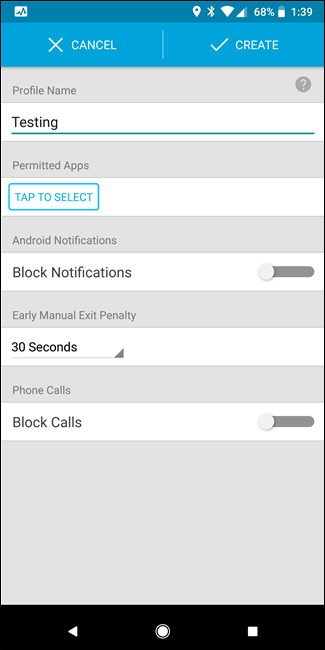
NOTE: If you choose to block notifications, you’ll have to grant Quality Time notification access, and if you want to block calls, you’ll have to allow the app access to the dialer. Both options will be presented to you if you try enable either feature.
注意:如果选择阻止通知,则必须授予“质量时间”通知访问权限,如果要阻止呼叫,则必须允许该应用程序访问拨号程序。 如果您尝试启用任一功能,将同时显示这两个选项。
Lastly, you’ll need to define a “Early Manual Exit Penalty,” which is a sort of cooldown timer that disallows you from using your phone if you choose to end your “break” early. Quality Time is mad serious about you actually putting your phone down, you guys.
最后,您需要定义“提前人工退出惩罚”,这是一种冷却计时器,如果您选择尽早结束“休息”,则禁止您使用手机。 伙计们,Quality Time对您实际上放下电话非常生气。
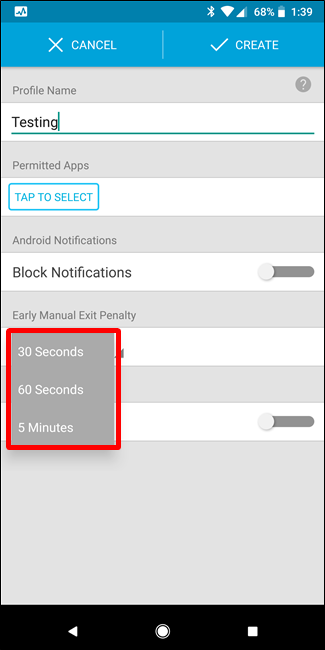
Once you’ve set your particular parameters, tap the “Create” button at the top.
设置完特定的参数后,点击顶部的“创建”按钮。
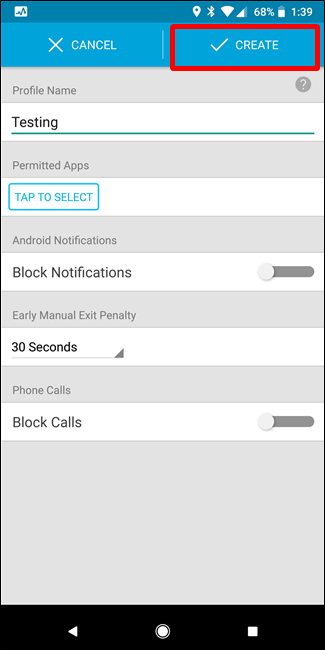
NOTE: Once you create a profile, you can’t delete it without first creating a second profile. In other words, once a profile has been created, you have to keep one at all times.
注意:创建配置文件后,必须先创建第二个配置文件才能删除它。 换句话说,创建配置文件后,您必须始终保留一个配置文件。
With your profile set up, open the menu and tap “Take a break” to use this feature. A new screen will show up asking you how long you want the break to be (and which profile, if you have more than one). Once set, just tap the “Start” button to start your break.
设置好个人资料后,打开菜单,然后点击“休息一下”以使用此功能。 将出现一个新屏幕,询问您希望休息多长时间(如果有多个,则选择哪个配置文件)。 设置后,只需点击“开始”按钮即可开始休息。
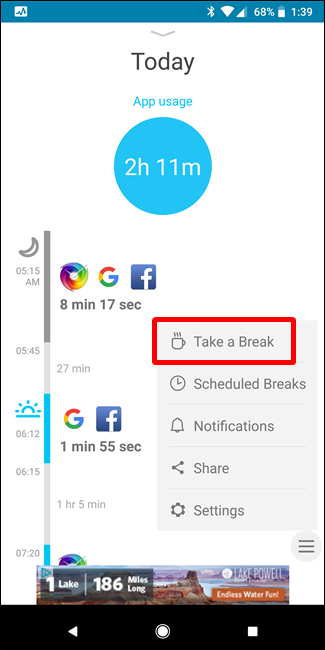
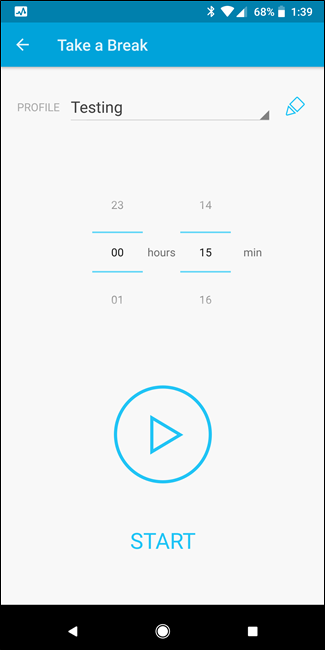
At that point, your phone is borderline useless. You can still press the home button to go to the home screen, but that’s it—whenever you try to launch an app, Quality Time will take over and launch the “break” screen. Unless otherwise specified, the only app allowed to bypass this screen is the dialer. Intense.
那时,您的电话已无用。 您仍然可以按主屏幕按钮进入主屏幕,仅此而已–每当您尝试启动应用程序时,Quality Time都会接管并启动“中断”屏幕。 除非另有说明,否则允许绕过此屏幕的唯一应用是拨号程序。 激烈。
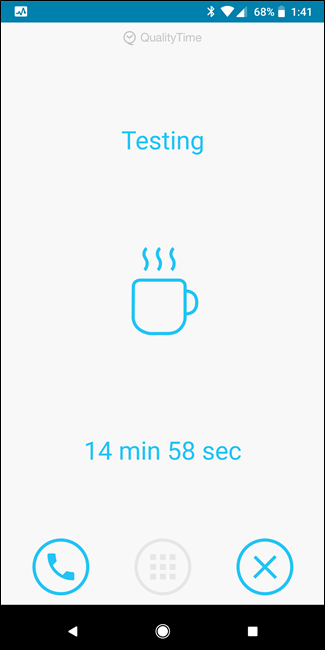
You can, however, end your break early by tapping the X in the bottom right. You will, however, have to wait out the “Early Manual Exit Penalty” that you set earlier, so keep that in mind. And once it’s over, you’ll also be force-fed an ad. Yuck.
但是,您可以通过点击右下角的X提前结束休息。 但是,您将不得不等待之前设置的“提前手动退出处罚”,因此请记住这一点。 结束后,您还将被强制投放广告。 uck
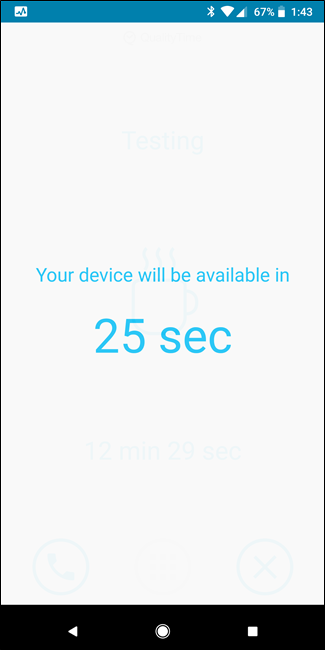
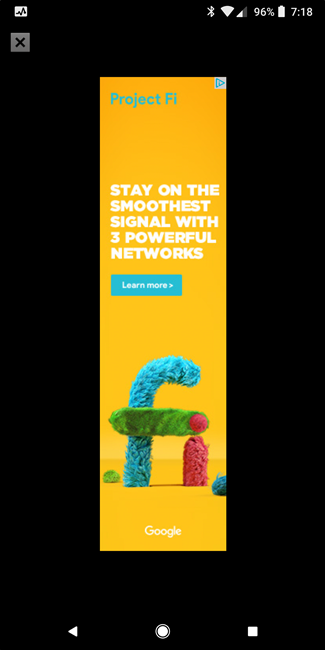
Otherwise, there are a few other things tucked in Quality Time’s Settings menu, like alert specifications for usage, unlocks, and even specific apps; IFTTT integration, and a Daily Recap notification (which is enabled by default).
否则,“质量时间”的“设置”菜单中还有其他一些内容,例如使用,解锁甚至特定应用的警报规范; IFTTT集成和每日回顾通知(默认情况下启用)。
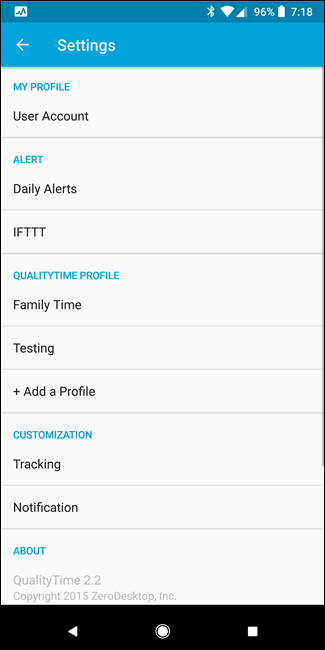
There’s also an option to block specific apps from being tracked under Settings > Tracking. I omitted my alarm app, Timely, because I don’t need to see how long I let it alarm before snoozing it…three or four times. Every day. Seriously.
在“设置”>“跟踪”下,还有一个阻止特定应用被跟踪的选项。 我省去了我的闹钟应用程序 Timely ,因为在暂停之前,我不需要知道闹钟让闹钟响了多长时间……三到四次。 每天。 说真的
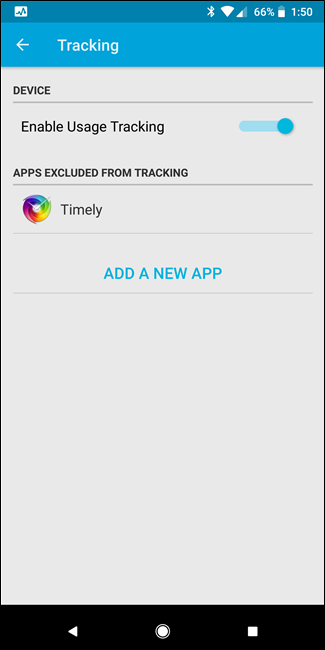
Overall, Quality Time is a nifty app that lets you quickly see how damn much you use your phone. Seriously, it’s a lot. Too much. Put it down.
总体而言,Quality Time是一个漂亮的应用程序,可让您快速查看手机的使用情况。 说真的,很多。 太多了。 放下它。
Of course, it’s not the only app that does this—there’s also App Usage—but I found Quality Time to be a bit more intuitive and offer a bit more info than App Usage. Still, they’re both excellent apps, and if Quality Time isn’t doing it for you, give App Usage a shot.
当然,它不是唯一执行此操作的应用程序 -还有应用程序使用情况 -但我发现质量时间比应用程序使用情况更直观,并提供了更多信息。 尽管如此,它们都是出色的应用程序,如果Quality Time不能为您做得到,请试用一下App Usage。
翻译自: https://www.howtogeek.com/339207/how-to-see-your-most-used-apps-on-android/
android应用常用框架







 本文介绍了一款名为QualityTime的应用,它能帮助你追踪并理解自己在手机上的使用习惯,包括每天和每周的使用时间、开启应用的频率及解锁屏幕的次数。这款应用提供了直观的界面,让你清晰看到哪些应用占据了你大部分的时间。
本文介绍了一款名为QualityTime的应用,它能帮助你追踪并理解自己在手机上的使用习惯,包括每天和每周的使用时间、开启应用的频率及解锁屏幕的次数。这款应用提供了直观的界面,让你清晰看到哪些应用占据了你大部分的时间。

















 被折叠的 条评论
为什么被折叠?
被折叠的 条评论
为什么被折叠?








